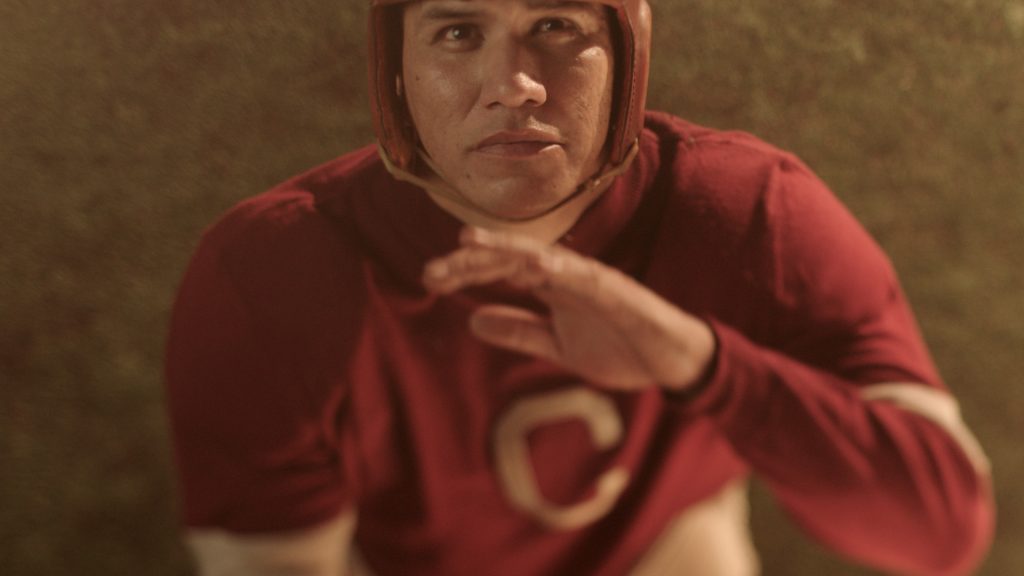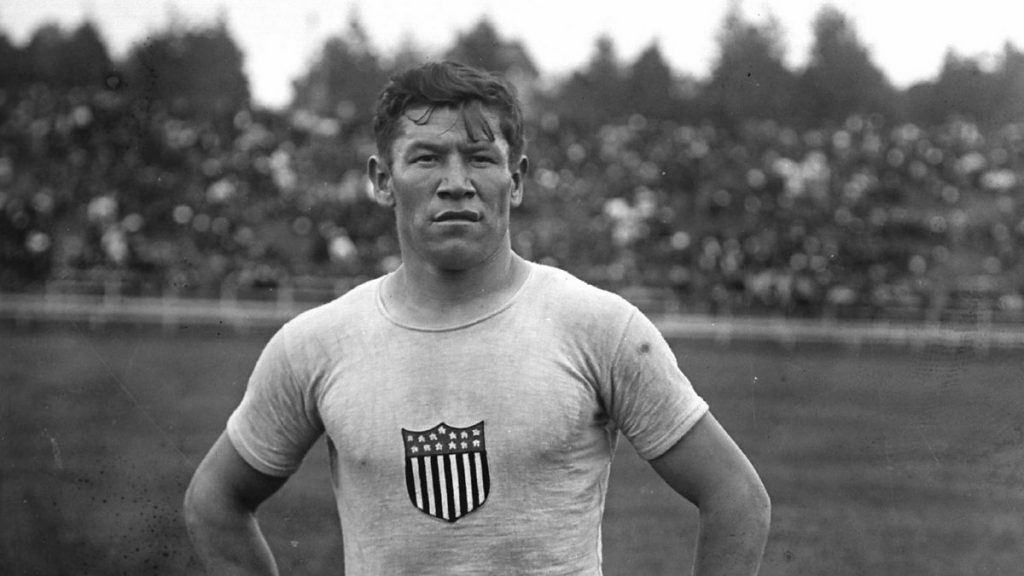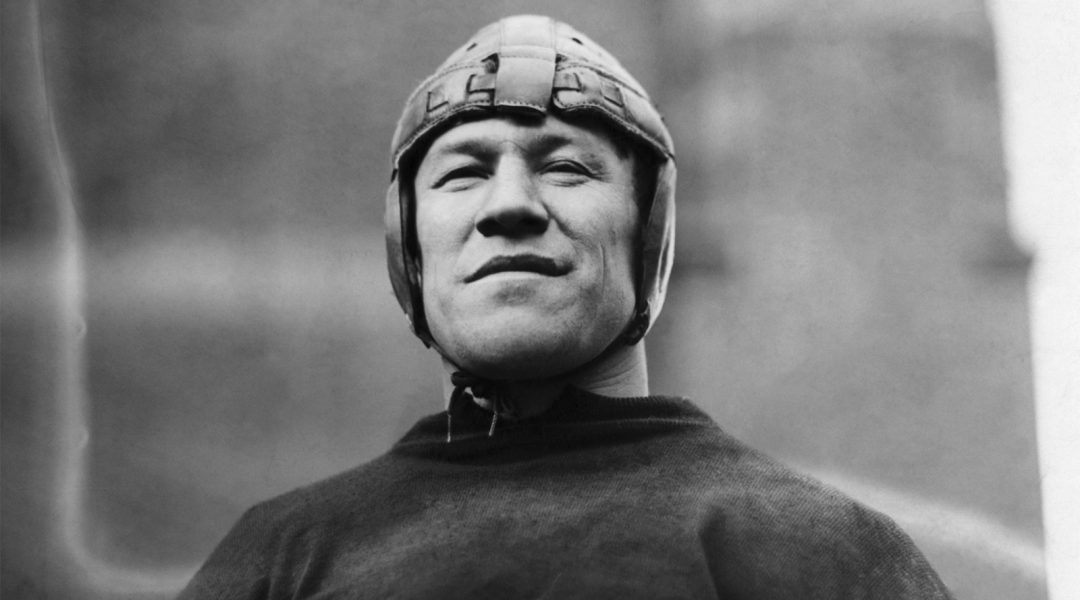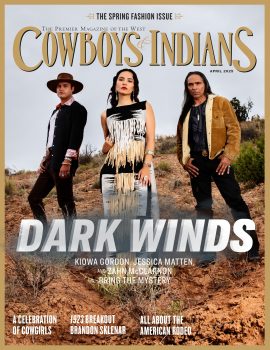Filmmaker Chris Eyre documents the amazing life story of the Native American icon often described as “The Greatest Athlete of All Time.”
Filmmaker Chris Eyre grew up hearing stories about the legendary Jim Thorpe, the first Native American Olympic gold medalist whose many and varied achievements in football, baseball, basketball, and track-and-field have led many sports historians to rank him among the greatest — if not the greatest — all-around athletes of all time.
Eyre, an Oregon native and member of the Cheyenne and Arapaho tribes, was fascinated by accounts of Thorpe’s unparalleled exploits and indomitable resilience.
He marveled at how Thorpe wound up winning in pentathlon and decathlon events at the 1912 Olympics while wearing mismatched shoes — retrieved from a garbage can — that were desperately improvised replacements after his own pair were stolen by a jealous rival. He felt his spirits lifted while hearing how Thorpe, who was born on the Sac and Fox Nation reservation in Central Oklahoma, was celebrated at as all-American hero at a time when, prior to the 1924 U.S. Indian Citizen Act, not all Indigenous people were considered real Americans.
And his was deeply saddened by learning that, because of a technicality involving Thorpe’s playing for a Minor League Baseball team prior to the 1912 Olympics, he was deemed disqualified for not being a true amateur and stripped of his medals.
In his documentary Jim Thorpe: Lit by Lightning, which premieres at 8 p.m. ET July 7 on the HISTORY Channel, and will be available after that on the HISTORY website, Eyre focuses on the man behind the legend, the truths behind the embellishments, to offer an enlightening and engrossing portrait of a man who repeatedly overcame adversity and exploitation, who endured setbacks and humiliations with his pride and perseverance undiminished, to forge his legacy as an enduringly inspirational icon.
Featuring excerpts from Thorpe’s unpublished autobiography narrated by artist-actor Dukon Harris, who also portrays Thorpe in scenes that recreate highlights from his life and times, Jim Thorpe: Lit by Lightning also features thoughtful interviews from scholars, sports commentators, and fellow athletes. It rivetingly, respectfully, and sometimes humorously charts the dizzying highs and brutal lows of a remarkable life, while taking care not to ever make Thorpe seem larger-than-life.

We recently spoke with Chris Eyre about Jim Thorpe: Lit by Lighting. And, yes, we also tried to get some advance info about Season 4 of Dark Winds, the great AMC series for which he serves as a director and executive producer. Here are some highlights from our conversation.
Discovering a Childhood Hero
Cowboys & Indians : Do you remember how old you were when you first heard of Jim Thorpe?
Chris Eyre: It’s funny. I was talking to my mom about this recent project, and she reminded me — and then I recalled — when I was in grade school, I must’ve been 5 or 6. I was told the story of Jim Thorpe and his mismatched shoes and him winning gold medals in the Olympics. And my mom recently said, “Remember that story?” And I said, “Wait a minute. You told me that when I was in first grade.” It was a point of pride that lived within me all these years.
I think that’s true for a lot of people. We need to be reminded of what our heroes did. In this social media age of information overload, sometimes we’ve just got to look at the basics. And that’s what this Native lens was for me with Jim Thorpe. It’s about the simplicity of why this underdog is revered as the greatest athlete ever — and why he’s a hero.
A Different Lens on Jim Thorpe
C&I: Was there anything that surprised you while you were doing your research?
Eyre: I started to look at him through a different lens. I went past just understanding the story — I started to understand him. I realized he was the first celebrity athlete, but he wasn’t doing it for money or fame. So I asked myself: What was he doing this for?
Then you realize: He lost his twin brother at 9, both parents by 11, was forced into Indian boarding school. You go one of two ways at that point. He survived. He thrived. He inspired.
In 1912, he was celebrated with ticker tape parades for winning the Olympics — even though Native people weren’t recognized as U.S. citizens until 1924. That’s the irony. Through a Native lens, you see he was a hard worker with no shame in his game. He dug ditches in the 1930s to build the L.A. County Museum, and people said it was a shame. But there was no shame. He worked hard and never felt sorry for himself.

Finding Strength in the Paradox
C&I: I want to be careful how I phrase this, but this is one of the few documentaries or dramatic films I’ve seen where it’s suggested that going to an Indian boarding school might have helped someone.
Eyre: There's a paradox in everything. My grandmother went to boarding school from age 5 to 18. She said it made her the domestic engineer she became — a maid — because she learned home economics. It was horrible in many ways, but it was also a means of survival.
Jim Thorpe ran away from Haskell several times. He even walked 200 miles home. When he went to [Carlisle Industrial Indian School in Pennsylvania], it was too far to run away. But he stayed and thrived. People talk about his “tragic life.” As a Native person, I see a celebrated life. He was the first president of what would become the NFL, he won professional titles with the Canton Bulldogs, played pro baseball and basketball, was a champion ballroom dancer — the list goes on.
Revisiting the Hollywood Legacy
C&I: Did you go back and watch Jim Thorpe — All-American, the 1951 Burt Lancaster biopic about Thorpe?
Eyre: I’d looked at it before and cringed. And I’ve watched it again recently. I think we need to make a new feature film about Jim Thorpe. It’s been in development hell for years. I’ve circled the idea myself and hope we’ll find a way to make it happen.
Ironically, in the documentary, we cast an actor named Dukon Harris for the reenactments — and he’s Sac and Fox, just like Thorpe. That was one of those serendipitous moments that made me feel like I was on the right path.
C&I: That was startling — he looks so much like Jim Thorpe. Way more than Burt Lancaster did.
Eyre: That’s when I said, “We’ve got something here.”
 Jim Thorpe at the 1912 Olympic Games in Stockholm, Sweden.
Jim Thorpe at the 1912 Olympic Games in Stockholm, Sweden.
If He Were Alive Today...
C&I: You emphasize this several times in the documentary: If he were doing even half of what he did back then today, he’d be a mega-star. But he got into trouble just for playing Minor League Baseball.
Eyre: Exactly. Dan O’Brien — the Olympic gold medalist — is in the film. He talks about how one bad event can ruin your decathlon standing. Jim Thorpe won both the decathlon and the pentathlon. That’s almost unthinkable today.
LeBron James produced this film. And Thorpe was voted the greatest athlete of the 20th century by the Associated Press. My job is to keep telling his story, because there’s so much there.
Sharing the Stage With History
C&I: I was fascinated to learn he crossed paths with Dwight Eisenhower and George Patton at Olympic events — and at one point, he even tried to break into the movies!
Eyre: That’s right. He’s even an extra in King Kong from the 1930s. I laugh about that — watching King Kong and wondering, “Is Jim Thorpe in that scene?” Evidently, he is. A fun bit of trivia.
The Message for Today’s Youth
C&I: What do you hope audiences take away from this documentary?
Eyre: Inspiration. A passion for not giving up. Jim Thorpe had so little and made so much out of it. I want young Native people to know he’s one of their heroes.
We screened the film at UNITY, the Native American Youth Conference, in front of 3,000 Native youth — and they cheered. That’s why I do it. So his name doesn’t get lost in the busyness of our time.
On Dark Winds
C&I: One last question: Are Joe and Emma going to get back together in Dark Winds?
Eyre: I just directed a scene with Joe and Emma the other day — no spoilers — but I’ll say this: It’s going to be good for Joe and Emma. I think it’s going to work out. Jim Thorpe would want it that way. And I heard a rumor that Joe Leaphorn’s hero was Jim Thorpe.
C&I: Maybe that can get slipped into an episode or two?
Eyre: Maybe so! That’s great connective tissue.














